A Healthy Woman Is An Empowered Woman
March 1, 2021
Do you know the 5 types of gynecologic cancers? March 8th is International Women’s Day, a good time to recognize the healthcare rights of women and girls and to raise awareness about critical illnesses like cancer.

International Women’s Day aims to help forge a gender equal world, celebrate women’s achievements, increase visibility, and call out inequality.
The health mission is to assist women to be in a position of power to make informed decisions about their health. Empowering women with the knowledge and tools about their health and rights has positive benefits on individuals and communities.
The Importance of Check-Ups
Due to the pandemic, many people have delayed or skipped getting necessary medical attention. This represents a serious risk because regular medical check-ups are vital for early detection and delaying treatment can reduce effectiveness.
It is especially important to recognize the signs and risks of cancer – the number one cause of death for women in many countries – and to keep going to routine medical examinations and not wait to seek professional medical advice if anything looks out of the ordinary.
Gynecologic Cancers
These cancers may not be as well-known as breast cancer, but they are more common than you might think. They are grouped together because the cancer results from the rapid growth and spread of abnormal spreads in one of the organs of the woman’s reproductive system.
Top 5 types:
- Cervical cancer
- Uterine cancer, or endometrial (the inner lining of the uterus) cancer
- Ovarian cancer
- Vaginal cancer
- Vulvar cancer
Knowing how to prevent and detect these cancers, which may be overlooked or confused with other ailments, can result in early treatment and saved lives.
Signs and Symptoms
Regular gynecologic exams are important because the symptoms of early-stage gynecologic cancers are often vague and may be confused or dismissed as something less serious.
Symptoms to be on the lookout for:
- Unusual vaginal discharge.
- Vaginal bleeding. More than 90% of women diagnosed with endometrial cancer experience irregular bleeding. Bleeding after sexual intercourse, between menstruation periods, or bleeding after menopause, can be a sign of cervical or vaginal cancer.
- Pain in the pelvis or abdominal area can occur with uterine and ovarian cancer.
- Bloating is a symptom of ovarian cancer. It may also cause constipation and an increased need to urinate.
- Vaginal and vulvar cancer causes itching and soreness along with a visible lesion. Doctors might perform a biopsy of the wound to look for abnormal cells.
Other warning signs you should not ignore are:
- Unexplained weight loss, such as losing more than 4-5 kilos suddenly without changing your diet or exercise habits.
- Loss of appetite or feeling full all the time and never hungry.
- Constant fatigue.
- Persistent indigestion or nausea.
- Change in bowel habits.
- Changes in your breasts.
Having one or more of these symptoms does not mean you have cancer but if they last two weeks or longer, seek a professional medical evaluation. Waiting until the symptoms are painful or bad enough to seek emergency attention can be reflective of a very advanced cancer.
Protect and Prevent
With regular check-ups, gynecologic cancers can often be easily treated if detected in the early stages. In fact, cervical cancer is the only malignant cancer in women that can be prevented by a vaccine.
Here are some of the most common risk factors to be aware of and steps to prevent reproductive cancers:
- Know about the Human papillomavirus (HPV): HPV is a major risk for cervical cancer. A staggering 99.7% of women diagnosed with cervical cancer are positive for HPV. The virus is a sexually transmitted infection so common that the Center for Disease Control and Prevention in the US estimates that 85% of people will contract it over their lifetime.
- Fortunately, the HPV vaccine can protect against the virus and against cervical abnormalities and genital warts. Cervical cancer is the only cancer that can currently be prevented by a vaccine. Vaccination, alongside screening and treatment, are the three pillars for the World Health Organization spearheaded global commitment to eradicate cervical cancer by 2050. All women are recommended to get the HPV vaccine and to do so from as young as 10 years. Speak to your doctor to find out more.
- The second key action to prevent cervical cancer is to have regular pap smear tests, every 1 or 2 years. Not all positive results mean cancer will develop, but monitoring is critical because cervical cancers arising from HPV typically take decades to develop.
- Address unhealthy weight and diet, drinking and smoking habits: attending to these risk factors early on significantly changes the likelihood of developing cancer and many other diseases. For example, alcohol consumption at any level is associated with an increased risk in breast and colorectal cancers amongst others. It will not take long for your fitness, energy, and mind to feel the benefits, and you can share them with your friends and family.
- Be aware of chlamydia infection: This common sexually transmitted disease can go undetected as it does not have symptoms. Chlamydia increases the risk of ovarian cancer through its role in pelvic inflammatory disease and is also a contributing factor in cervical cancer. Regular testing allows medical professionals to spot and treat it.
- Education on hormone replacement therapy: The link between cancer and hormones has to do with cells multiplying. For some women, replacing declining hormones can alleviate some of the unpleasant symptoms of menopause. But hormone replacement therapy also raises the risk of breast cancer and ovarian cancer. Most doctors will recommend safer ways to reduce the symptoms of menopause and non-hormonal alternatives.
- Take note of hereditary reasons: Cancer is a genetic disease, meaning it is caused by certain changes to genes that control the way cells grow and divide. Everyone has some risk of developing cancer, and in many cases the disease develops randomly. However, in some cases, cancer can also present itself as a hereditary occurrence.
While cancer itself is not inherited, the genetic defect that can – or cannot – lead to cancer is. Patients with ovarian cancer often have a family history of cancer. It is good practice to take extra precautions and monitoring through regular testing if there is a history of cancer in your family.
Act Today
If you have not had your regular medical check-up, do not put it off any further.
If you have symptoms, or even if you are unsure that you do, speak to your doctor. Catching things early, or ruling them out, is the safest option.
Knowing about your health and how your body works in health and illness gives you the power to act, get the right attention and support, and address any challenges.
Sources:
- MD Anderson. Nathan-Garner L. August 2014. “10 cancer symptoms women shouldn’t ignore”.
- Tacio H. 16 May 2019. “Cervical cancer: second-most common cancer among women”. Business Mirror.
- Centers for Disease Control and Prevention, “Reasons to get vaccinated”.
- Brotherton J. “Impact of HPV vaccination: achievements and future challenges” Papillomavirus Res. June 2019; 7: 138-140.
- World Health Organization, 17 November 2020. “A cervical cancer-free future: first ever global commitment to eliminate a cancer”.
- MD Anderson, Underferth D. September 2017. “Hormones and cancer: what’s the link?”
- Banks N. et al. 24 September 2019. “How does menopausal hormone replacement therapy (HRT) affect ovarian cancer risk?” Medscape.
